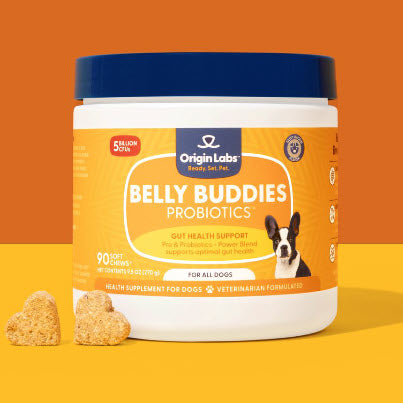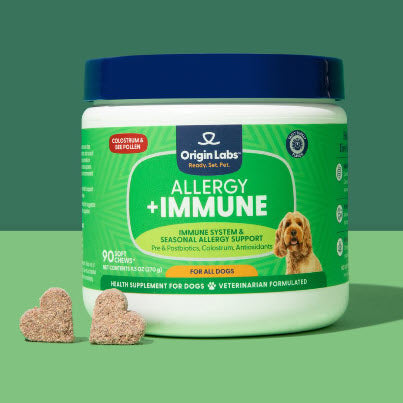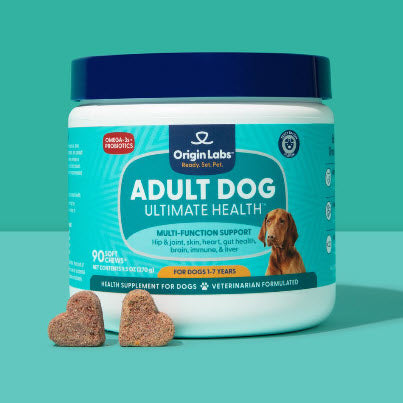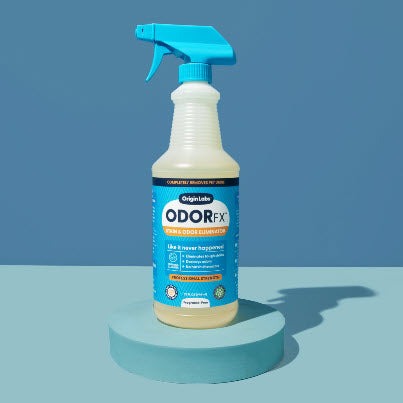Introduction
Can dogs safely consume rhubarb? This question often arises among pet owners who prioritize the health and well-being of their canine companions. Rhubarb, known for its tart flavor and commonly used in pies and desserts, may seem like an innocuous addition to a dog's diet, but there are potential risks involved.
In this article, we will explore:
- The potential risks and benefits of feeding rhubarb to dogs
- Insights on safe fruits for dogs, including raspberries
Prioritizing the health of our pets involves understanding what foods can be harmful. By examining rhubarb toxicity and its effects on dogs, we aim to provide a comprehensive guide to help you make informed decisions about your pet's diet, which includes considering options like the Adult Dog Ultimate Health formula from Origin Labs. Origin Labs supplements are designed to support your dog at each stage of their life.
Understanding Rhubarb and Its Potential Effects on Dogs
What is Rhubarb?
Rhubarb is a perennial vegetable known for its tart stalks, which are commonly used in pies, jams, and other culinary dishes. Typically found in gardens and grocery stores, rhubarb is recognizable by its large green leaves and long red or green stalks. While people often eat the stalks, it's important to know how rhubarb can affect dogs.
Can Dogs Eat Rhubarb Leaves?
No, dogs should not eat rhubarb leaves. Rhubarb leaves contain high levels of oxalic acid, which can be toxic to both humans and dogs. Oxalic acid can combine with calcium in the body to form calcium oxalate crystals, leading to serious health problems such as:
- Kidney damage
- Low calcium levels
- Gastrointestinal distress
Because of these risks, it's crucial to keep rhubarb leaves away from your pets.
Why Some Experts Advise Against Feeding Rhubarb to Dogs
Many veterinary experts caution against giving rhubarb to dogs because it can be toxic. The main concern is the high amount of oxalic acid in rhubarb leaves, although smaller amounts are also present in the stalks. Consuming large quantities of this compound can cause:
- Vomiting
- Diarrhea
- Lethargy
- Tremors
While some experts believe that small portions of cooked rhubarb stalks may not be immediately harmful, it's generally recommended to be cautious due to variations in individual dog sensitivities and the challenge of accurately measuring safe amounts.
Factors Influencing Risk Levels
Several factors play a role in determining how risky it is for dogs to eat rhubarb:
- Quantity Ingested: Larger amounts increase the risk of toxicity.
- Preparation Method: Cooking may reduce oxalic acid content but doesn't eliminate it entirely.
- Size and Health of the Dog: Smaller dogs or those with pre-existing health conditions may be more susceptible.
Understanding these factors can help pet owners make informed decisions about what foods are appropriate for their canine companions. It's essential to prioritize your dog's well-being by being aware of potential dietary risks and making informed choices accordingly.
Examining the Potential Risks: Rhubarb Toxicity in Dogs
Signs That May Indicate a Dog Has Ingested Toxic Amounts of Rhubarb
Dogs that consume rhubarb, especially the leaves, may exhibit various symptoms indicative of toxicity. Recognizing these signs early can be crucial for prompt treatment:
- Vomiting: One of the most common symptoms.
- Diarrhea: Loose or watery stools.
- Excessive Drooling: Increased saliva production.
- Tremors or Seizures: Muscle tremors or full-body seizures.
- Lethargy: Unusual tiredness or weakness.
- Loss of Appetite: Refusal to eat or reduced interest in food.
- Difficulty Breathing: Shortness of breath or labored breathing.
Symptoms can vary in severity depending on the amount ingested and the size of the dog. Immediate attention is crucial if any of these signs are observed.
Immediate Steps to Be Taken If You Suspect Your Dog Has Consumed Rhubarb or Its Leaves
If you suspect your dog has ingested rhubarb, swift action is essential to mitigate potential health risks. Here are the steps you should follow:
1. Identify the Amount Consumed:
- Determine how much rhubarb your dog might have eaten. If possible, note whether your dog ingested leaves, stems, or both.
2. Contact Your Veterinarian Immediately:
- Call your vet and inform them about the situation. Describe your dog's symptoms and provide details on the quantity consumed.
3. Induce Vomiting (Only If Advised by a Vet):
- Do not induce vomiting unless specifically instructed by a veterinary professional. Incorrectly inducing vomiting can cause more harm than good.
4. Provide Fresh Water:
- Ensure your dog has access to plenty of fresh water to help flush out toxins.
5. Monitor Symptoms Closely:
- Keep a close eye on your dog's condition, noting any changes in behavior, appetite, or physical symptoms.
6. Avoid Home Remedies Without Professional Guidance:
- Refrain from giving any home remedies without consulting your veterinarian first as they might exacerbate the problem.
Prompt action can significantly reduce the severity of rhubarb toxicity and improve outcomes for your furry friend.
Specifics on Why Rhubarb is Generally Not Recommended for Dogs
Higher Concentration of Toxins in Rhubarb Leaves
Rhubarb leaves contain a higher concentration of toxins, such as oxalic acid, compared to the stems. Oxalic acid is a naturally occurring compound that can interfere with the body's ability to absorb calcium, leading to severe health issues.
Potential Harm to a Dog's Health
Oxalic Acid and Kidney Function
- Calcium Oxalate Crystals: When dogs eat rhubarb, oxalic acid can combine with calcium in their bodies to form calcium oxalate crystals. These crystals can build up in the kidneys, leading to kidney stones and other renal issues.
- Renal Failure: In severe cases, the buildup of these crystals can cause acute renal failure, which is life-threatening and requires immediate veterinary intervention.
Other Health Concerns
- Gastrointestinal Distress: Consuming rhubarb leaves can cause vomiting, diarrhea, and abdominal pain.
- Neurological Symptoms: High levels of oxalic acid can also affect the nervous system, leading to symptoms like tremors or seizures.
Veterinarians often advise against feeding rhubarb to dogs due to these potential risks. While some sources might suggest that small amounts of rhubarb stems could be safe if properly prepared, the presence of the plant's leaves poses significant danger.
However, there are numerous fruit options that are safe for your dog's diet and offer essential vitamins and antioxidants. If you're interested in exploring these alternatives further, you may find this article on What Fruits Can Dogs Eat? helpful.
Prioritizing your dog's safety and well-being means being aware of the dangers posed by certain foods like rhubarb. While rhubarb stems might be less toxic than the leaves, erring on the side of caution is always recommended when it comes to your pet's diet.
Can Dogs Safely Eat Cooked Rhubarb?
The potential risks of rhubarb, especially the oxalic acid in its leaves, make people worried about whether it's safe for dogs. Cooking rhubarb can lower the levels of oxalic acid, making it a bit safer for them to eat. But we still need to know how much the acid decreases when cooked and if it's okay to give dogs cooked rhubarb as a treat.
Cooking and Oxalic Acid Reduction
Cooking rhubarb helps to break down some of the oxalic acid present in the plant. This process can slightly diminish the toxicity levels:
- Boiling: Boiling rhubarb can leach out some of the oxalic acid into the water. Discarding the water after boiling may reduce the overall toxicity.
- Baking or Stewing: These methods may also lower oxalic acid levels but not as effectively as boiling.
Despite these reductions, cooking does not entirely eliminate oxalic acid from rhubarb. The residual amounts can still pose a risk, particularly if consumed in large quantities or frequently.
Moderation is Key
Feeding dogs small amounts of cooked rhubarb might seem tempting due to its potential health benefits, such as vitamins and fiber. However, moderation is crucial:
- Small Portions: Only very small portions should be offered occasionally.
- Avoid Leaves: Ensure only stems are used, as leaves contain higher concentrations of toxins.
Vet Consultation Recommended
It’s beneficial to consult with a veterinarian before introducing cooked rhubarb to your dog's diet. They can provide guidance based on your dog's specific health needs and dietary restrictions.
Note: While cooking reduces oxalic acid levels, it does not guarantee safety. Other dog-friendly fruits and vegetables may offer similar nutritional benefits without associated risks.
Understanding these aspects ensures that you make informed decisions about what treats are genuinely safe for your canine companions.
Safe Alternatives and Healthy Treat Ideas for Your Dog
When it comes to treating your furry friend, there are plenty of dog-friendly fruits and vegetables that not only provide nutritional benefits but are also safe. Below are some excellent choices:
Dog-Friendly Fruits
- Apples: Rich in vitamins A and C, apples can support a dog's immune system. Just remember to remove the seeds and core.
- Blueberries: Packed with antioxidants, blueberries are great for promoting overall health.
- Bananas: High in potassium, bananas can help regulate blood pressure and heart function.
For more information on safe fruits for dogs and their nutritional benefits, you may also want to consider reading about the safety of pears and whether dogs can eat plums. These articles provide insights into other safe fruit options for dogs, their nutritional benefits, risks, and safe feeding tips. Understanding these risks and knowing how to respond can make all the difference in keeping your dog safe and healthy.
Vegetables for Dogs
- Carrots: A low-calorie snack that's good for dental health due to its crunchy texture.
- Green Beans: Loaded with vitamins and minerals, green beans are a great source of fiber.
- Sweet Potatoes: High in dietary fiber and beta-carotene, sweet potatoes can aid in digestion.
While rhubarb can pose risks to dogs, there are other fruits and vegetables that may be beneficial for their health. Can Dogs Eat Pumpkin? provides insights into the nutritional benefits of feeding pumpkin to dogs, safety considerations, best practices, and creative ways to incorporate it into their diet.
Recipe: Homemade Dog Treats
For those looking to make their own dog treats at home with safe ingredients, try this simple recipe that excludes rhubarb leaves but utilizes the stems for added flavor:
Ingredients:
- 2 cups whole wheat flour
- 1 cup rolled oats
- 1/2 cup cooked rhubarb stems (ensure they're thoroughly cooked to reduce oxalic acid)
- 1/4 cup peanut butter (ensure it's xylitol-free)
- 1 ripe banana, mashed
- 1 egg
Instructions:
- Preheat your oven to 350°F (175°C).
- In a large bowl, mix the flour and oats.
- Add the cooked rhubarb stems, peanut butter, mashed banana, and egg to the dry ingredients.
- Stir until well combined.
- On a floured surface, roll out the dough to about 1/4 inch thick.
- Use cookie cutters to cut out shapes or simply cut into small squares.
- Place treats on a baking sheet lined with parchment paper.
- Bake for 20-25 minutes or until golden brown.
Allow the treats to cool completely before serving them to your dog. Store the leftovers in an airtight container.
Offering these safe fruits, vegetables, and homemade treats ensures your dog enjoys a variety of flavors while maintaining their health and well-being.
In Summary: Can Dogs Eat Rhubarb Responsibly?
Small amounts of rhubarb stems may not pose an immediate threat to dogs. However, it is generally recommended to err on the side of caution and avoid feeding them rhubarb or its leaves due to the potential risks involved. The higher concentration of toxins, such as oxalic acid in rhubarb leaves, can be particularly harmful.
When considering introducing any new food or treat to your dog's diet:
- Consult with your veterinarian: Always seek professional advice to ensure the safety and health of your canine companion.
- Monitor for adverse reactions: Keep an eye out for any signs of distress after your dog consumes new foods.
Prioritizing the well-being of our pets means making informed decisions about their diet. Keeping rhubarb off their menu is a prudent step in safeguarding their health.
FAQs (Frequently Asked Questions)
Can dogs safely consume rhubarb?
While small amounts of rhubarb stems may not pose an immediate threat to dogs, it is generally recommended to err on the side of caution and avoid feeding them rhubarb or its leaves due to the potential risks involved.
What exactly is rhubarb?
Rhubarb is a plant with edible stalks that are commonly used in cooking and baking. It is available in the form of fresh stalks, as well as processed into jams, sauces, and desserts.
Can dogs eat rhubarb leaves?
No, dogs should not eat rhubarb leaves as they contain a higher concentration of toxins, such as oxalic acid, which can be harmful to a dog's health.
What are the signs that may indicate a dog has ingested toxic amounts of rhubarb?
Signs of rhubarb toxicity in dogs may include drooling, vomiting, diarrhea, abdominal pain, tremors, and changes in urine color. If you suspect your dog has consumed rhubarb or its leaves, immediate veterinary attention is necessary.
Can cooking reduce the oxalic acid content in rhubarb, making it safer for dogs to consume?
The cooking process can effectively reduce the oxalic acid content in rhubarb to some extent. However, it is still generally advised to avoid feeding rhubarb to dogs due to the potential risks involved.
What are some safe alternatives and healthy treat ideas for dogs?
Safe alternatives for dogs include fruits like apples and bananas, as well as vegetables like carrots and green beans. A homemade dog treat recipe that excludes rhubarb leaves but utilizes the stems for added flavor and potential health benefits can be a healthier option for dogs.








